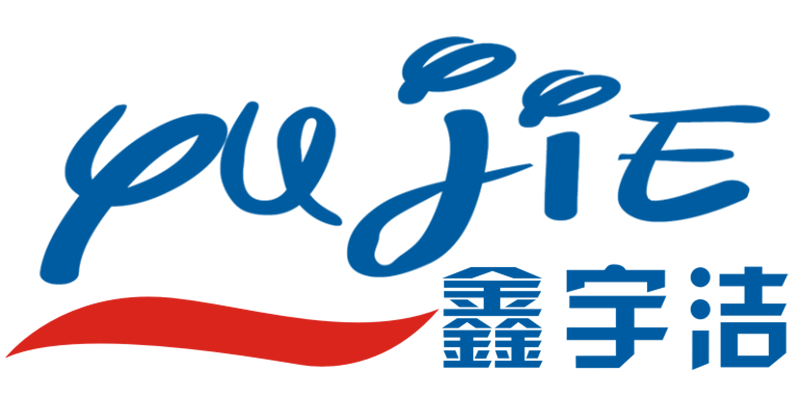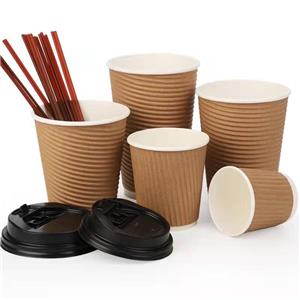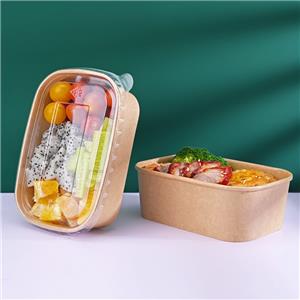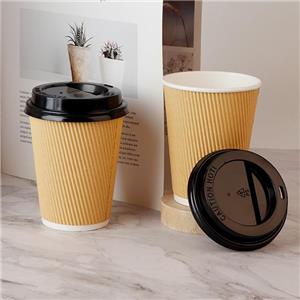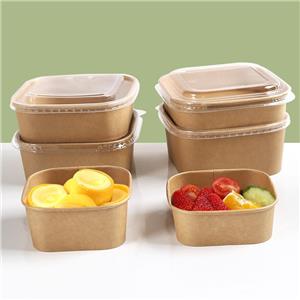Coffee Cup Sizes: The Ultimate Guide for Coffee Shops 2025
Coffee Cup Sizes: The Ultimate Guide for Coffee Shops 2025
Introduction
If you’re a coffee shop owner, barista, or just a coffee aficionado. In that case, you know that making the perfect cup of coffee goes way beyond choosing high-quality beans or mastering the right brewing technique. One often overlooked but crucial factor is choosing the right cup size. The size of your coffee cup can affect not only the flavour experience but also the aroma and overall presentation of the drink.
In this guide, we’ll dive into the world of coffee cup sizes, covering standard measurements, cultural differences, and how these choices affect the coffee experience.
Whether you’ve been in the coffee business for years or are just starting, knowing the finer details of coffee cup sizing is key. We’ll look at the sizes offered by popular coffee chains, what to consider when choosing cup sizes for your shop, and recommend a trusted paper coffee cup supplier to help you make the right decision.
So let’s get started and uncover the secrets of coffee cup sizes—so every cup you serve is the perfect one.
The Standard Coffee Cup Size: How Many Ounces?
As the standard cup size is discussed, we should distinguish between paper coffee cups and mugs because they usually have different capacities and they are designed to meet different purposes.
Paper Coffee Cups:
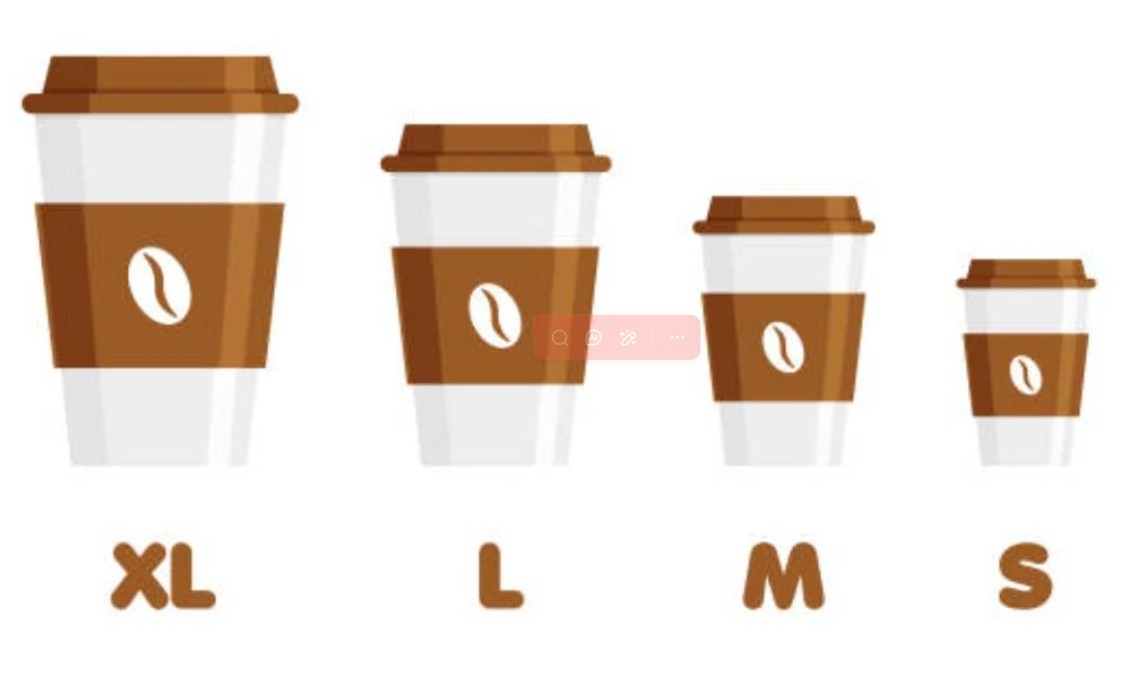
Disposable coffee cups are primarily made from paper or plastic. With growing environmental awareness, paper coffee cups have become increasingly prevalent, especially for hot beverages. Paper offers better insulation, often enhanced with double walls or sleeves, keeping coffee warm while protecting hands, making it the standard for convenient takeaway hot drinks.
Generally, the standard size for takeaway coffee cups is 8 fl oz (236.6 milliliters), the standard size for a cup in the coffee industry. Nevertheless, disposable coffee cups can be found in various sizes to meet different consumers’ preferences and drink choices.
Common coffee size chart include:
| Size Name | Volume (oz / ml) | Typical Use | Coffee Types Suited | Common Settings |
|---|---|---|---|---|
| 4 oz | 4 oz / 118 ml | 4 oz cups are typically used for espresso shots or small tasting cups. Ideal for concentrated servings like espresso or coffee samples in cafes. Small size for strong, concentrated drinks. | Espresso, Ristretto, Macchiato | Cafes, Tasting events |
| 6 oz | 6 oz / 177 ml | 6 oz cups are used for smaller servings of coffee, such as a small black coffee or a cortado. This size is great for single espresso shots with a bit of milk, or other small specialty coffees. | Small black coffee, Cortado, Single espresso with a bit of milk | Cafes, Takeaway |
| 8 oz | 8 oz / 237 ml | 8 oz cups are ideal for regular coffee sizes like a small Americano or a flat white. Common for standard-sized single coffees with milk or cream, providing a balanced amount for a small drink. | Americano, Flat white, Single coffee with milk or cream | Cafes, Takeaway |
| 10 oz | 10 oz / 296 ml | 10 oz is a medium size commonly used for cappuccinos or medium-sized black coffee. It offers a good portion size for a more robust serving of coffee while still being manageable in terms of volume. | Cappuccino, Medium black coffee | Cafes, Takeaway, Offices |
| 12 oz | 12 oz / 355 ml | 12 oz is a very popular size for coffee shops, used for drinks like lattes, regular black coffee, or flavored coffees. Common for both takeaway and in-store consumption, it’s a versatile size for a variety of drinks. | Latte, Regular black coffee, Flavored coffees | Takeaway, In-store consumption |
| 16 oz | 16 oz / 473 ml | 16 oz cups are commonly used for larger drinks like iced coffee or large lattes. This size allows for more milk or ice, making it ideal for cold beverages and those preferring a larger portion of their coffee or specialty drinks. | Iced coffee, Large lattes, Cold beverages | Takeaway, In-store consumption |
| 20 oz | 20 oz / 591 ml | 20 oz cups are typically used for very large drinks like iced lattes, large iced coffees, or frappes. Ideal for customers who prefer more drink volume or those who enjoy a substantial coffee with milk and flavoring. | Iced lattes, Large iced coffee, Frappes | Takeaway, In-store consumption |
In the United States—and many other countries—these popular coffee cup sizes are widely in demand. Some coffee shops also offer extra‑large options, such as 24 fl oz (709.8 ml) or even 32 fl oz (946.4 ml), catering to customers who prefer bigger portions or those who wish to share their drink with others.
To further complement our discussion on paper coffee cup sizes, this video provides expert café advice on selecting the right size for your needs.
Mugs:
Mugs are a popular choice for enjoying coffee, whether at a café or in the comfort of your home. They come in a wide range of sizes and styles. The standard size for a coffee mug typically ranges from 8 to 10 fl oz (236.6 to 295.7 ml), which aligns closely with the regular size of paper coffee cups. However, mug sizes can vary depending on the type of coffee being served and the intended use. Specialty mugs designed for espresso or cappuccino, for instance, may have different dimensions. The size of the mug plays a key role in determining how much coffee it can hold and how comfortable it is to drink from. Knowing the various mug sizes is essential for selecting the right one for your drink, whether you’re opting for a small cup of coffee or a larger mug for a more substantial serving.
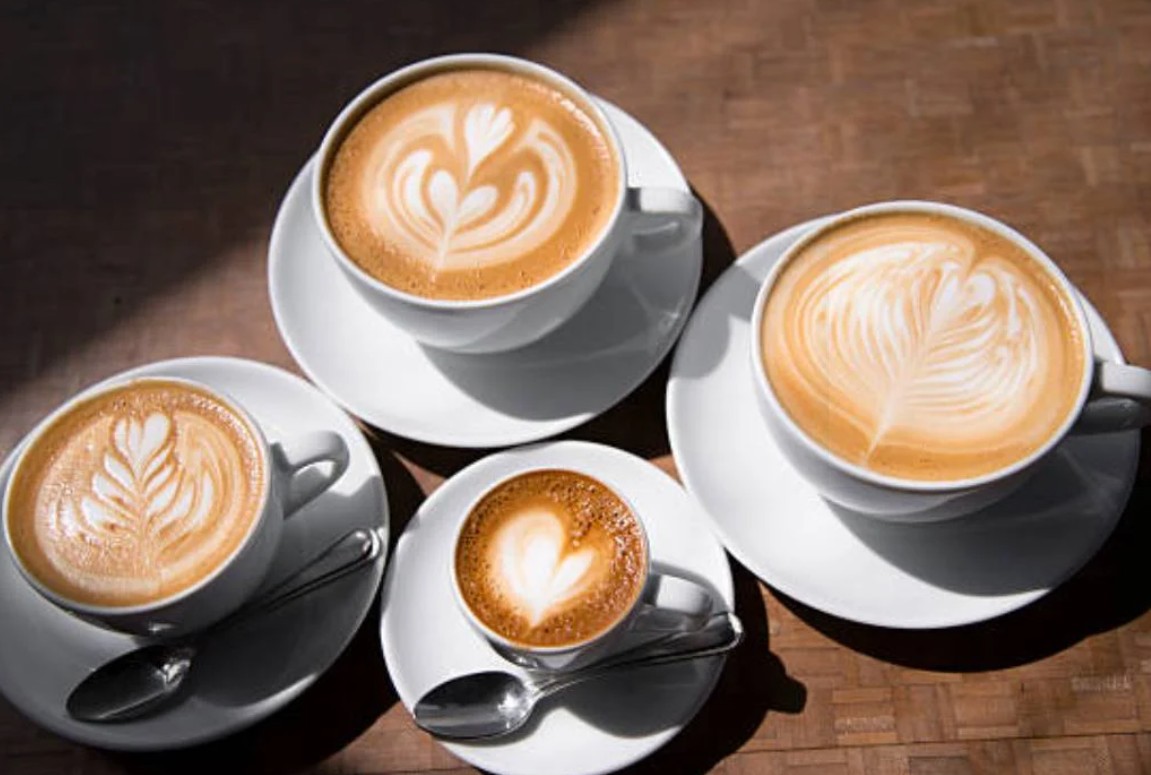
Here’s a detailed guide to some common coffee mug ounces sizes:
| Size Name | Volume (oz / ml) | Typical Use | Coffee Types Suited | Common Settings |
| Demitasse (Espresso cup) | 2–3 oz / 60–90 ml | Designed for single or double espresso shots | Espresso, Ristretto, Macchiato | Cafes, Espresso bars, Home espresso setups |
| Small Mug | 6–8 oz / 180–240 ml | For modest coffee drinkers or light brews | Black coffee, Flat White, Cortado | Home, minimalist cafés, hotel rooms |
| Standard Mug | 10–12 oz / 300–355 ml | The most common mug size for regular coffee consumption | Drip Coffee, Americano, Latte, Cappuccino | Home kitchens, Offices, Coffee shops |
| Large Mug | 14–16 oz / 415–475 ml | For bigger servings; allows room for milk, foam, or flavor shots | Lattes, Large Cappuccinos, Chai Latte | Cafés, Workspaces, Coffee enthusiasts |
| Oversized Mug | 18–20 oz / 530–590 ml | For people who want to “nurse” a coffee for a long time or enjoy big iced drinks | Iced Coffee, Mocha, Tea Lattes, Hot Chocolate | Home (especially winter), Cozy cafes |
| Travel Mug | 16–20 oz / 475–590 ml | Designed for spill-proof portability and heat retention | Any type—usually brewed coffee, lattes, or tea | Commuters, Offices, Road trips |
| Jumbo / Soup Mug | 20–24 oz / 590–710 ml | Technically a mug, but often used for soup or massive hot beverages | Extra-large mochas, hot chocolate, soup | Home (cold weather), Relaxation settings |
The best mugs come in various sizes, shapes, and materials, featuring options like porcelain, ceramic, glass, and stainless steel. Each material offers its unique aesthetic and drinking experience. When selecting the size and style of mugs for your coffee shop, consider factors such as your menu offerings, customer preferences, and the overall branding of your establishment. These elements will guide you in choosing the right mugs that align with your shop’s identity and enhance the overall coffee-drinking experience.
To complement our discussion on the size of coffee mug, here is a video will guide you through how to choose the best coffee cups for your café, taking into account both size and functionality.
Glassware:
Glassware is another excellent choice for serving coffee, especially for specific drinks. It offers a clean, modern aesthetic and allows customers to appreciate the beautiful layered effect of their beverage. Furthermore, the non-porous nature of glass ensures it won’t retain flavors or odors from previous drinks.
Here is a detailed guide to common glassware used in cafes:
| Size Name | Volume (oz / ml) | Typical Use | Coffee Types Suited | Common Settings |
|---|---|---|---|---|
| Demitasse Glasses | 2–4 oz / 60–120 ml | Designed for single or double espresso shots | Espresso, Ristretto, Macchiato | Cafes, Espresso bars, Home espresso setups |
| Latte Glasses | 8–12 oz / 240–350 ml | Tall, straight-sided glasses for lattes and iced coffees | Latte, Iced Coffee, Cold Brew | Cafés, Modern restaurants |
| Cappuccino Glasses | 5–7 oz / 150–210 ml | Often tulip-shaped glasses to concentrate aroma | Cappuccino, Cortado, Macchiato | Cafés, Home coffee brewers |
| Irish Coffee Mugs | 6–8 oz / 180–240 ml | Specialty glasses with a handle for layered hot drinks | Irish Coffee, Spiced Tea, Hot Chocolate | Bars, Restaurants, Home (cold weather) |
Using glassware can elevate your beverages for social media appeal and provides a chic option for in-house dining. When selecting glass, it’s essential to opt for thick, high-quality tempered glass to guarantee durability and effective heat retention. This choice not only enhances the presentation but also ensures that your drinks stay warmer for longer.
Stainless Steel Cups:
Stainless steel cups and tumblers are highly valued for their durability, superior insulation, and portability. They are a go-to choice for reusable travel mugs, keeping hot drinks hot and cold drinks cold for extended periods. Their robust, non-breakable nature makes them ideal for on-the-go lifestyles, outdoor activities, and workspaces. High-quality stainless steel should not impart any metallic flavor to the coffee, ensuring a pure taste experience.
| Size Name | Volume (oz / ml) | Typical Use | Coffee Types Suited | Common Settings |
|---|---|---|---|---|
| Tumbler | 12–16 oz / 355–475 ml | Reusable, insulated cup for daily use. | Hot coffee, Iced coffee, Lattes, Cold brew | Offices, Commutes, Home, Outdoor use |
| Travel Mug | 16–20 oz / 475–590 ml | Designed with a lid and handle for easy, spill-proof transport. | Any coffee type, especially large lattes and iced drinks | Cars, Commutes, Travel |
| Large Tumbler | 24–32 oz / 710–946 ml | For those who want to “nurse” their coffee all day or for large cold drinks. | Large iced lattes, Frappes, Cold brew | Desk, Gym, Home |
Plastic Cups:
Plastic cups offer a lightweight and versatile solution, particularly suited for cold beverages such as iced coffee. Their affordability and durability make them a favored option for takeaway services, especially when a transparent, visually appealing presentation of layered drinks is desired. While certain types of plastics, like polypropylene (PP), can accommodate hot drinks, most are recommended for cold beverages to prevent issues like flavor transfer or warping.
| Size Name | Volume (oz / ml) | Typical Use | Coffee Types Suited | Common Settings |
|---|---|---|---|---|
| Small Plastic Cup | 8–12 oz / 237–355 ml | Used for small iced coffees or cold brews. | Iced coffee, Cold brew, Iced tea | Takeaway, Catering, Events |
| Medium Plastic Cup | 16–20 oz / 473–591 ml | Standard size for most iced lattes and larger cold beverages. | Iced lattes, Frappes, Large iced coffee | Takeaway, Coffee shops, Convenience stores |
| Jumbo Plastic Cup | 24–32 oz / 710–946 ml | For extra-large cold drinks and customizable options. | Iced lattes, Frappes, Specialty iced drinks | Takeaway, Convenience stores |
What Are the Common Cup Sizes at Popular Coffee Shops?
While talking about the common cup sizes at the popular coffee shop, it has to be noted that the size of the paper cups used for takeaway order differs from the size of the mugs used for in-store consumption.
Takeaway Paper Cup Sizes:
1. Starbucks:
Tall: 12 fl oz (354.9 ml)
Grande: 16 fl oz (473.2 ml)
Venti: 20 fl oz (591 ml) for hot drinks, 24 fl oz (709.8 ml) for cold drinks
2. Dunkin’ Donuts:
Small: 10 fl oz (295.7 ml)
Medium: 14 fl oz (414 ml)
Large: 20 fl oz (591 ml)
3. Costa Coffee:
Primo: 12 fl oz (354.9 ml)
Medio: 16 fl oz (473.2 ml)
Massimo: 20 fl oz (591 ml)
These sizes are tailored to customers who like the bigger portions or who want to have coffee with them. The biggest sizes will also enable you to include things like milk, cream, or other flavorings without affecting the coffee-to-ingredient ratio.
In-Store Mug Sizes:
When it comes to in-store consumption, coffee shops typically use mugs sized around 8 to 10 fl oz (236.6 to 295.7 ml). However, the exact dimensions can vary depending on the specific beverage being served.
Espresso Cup: Often served in small demitasse cups that hold 2 to 3 fl oz (59 to 89 ml) to enhance the rich and aromatic flavors of espresso.
Cappuccino Cup: Usually designed for 6 to 8 fl oz (177.4 to 236.6 ml), these mugs are perfect for containing the espresso, steamed milk, and milk foam in harmony.
Latte Cup: Typically larger, lattes are served in cups ranging from 10 to 12 fl oz (295.7 to 354.9 ml) to accommodate both espresso and a more generous amount of steamed milk.
Regular Coffee Cup: Generally, 8 to 10 fl oz (236.6 to 295.7 ml) mugs are used, aligning closely with the standard size for a "cup" of coffee.
Some coffee shops may also offer larger mug sizes ranging from 12 to 16 fl oz (354.9 to 473.2 ml) for customers who prefer more substantial servings or want to relax while enjoying their coffee.
It’s important to note that while major coffeehouse chains have significantly influenced standard cup sizes, independent coffee shops often customize their offerings based on unique concepts and customer preferences. As a coffee shop owner, considering both takeaway and in-store cup sizes is essential when designing your menu and ordering custom coffee cups, ensuring that you meet the diverse needs of your clientele.
Cultural Differences in Coffee Cup Sizes
While you are focusing on the cultural differences in takeaway cups and in-store mugs, you should also understand that the sizes of the cups may vary from country to country as well as from local coffee traditions.
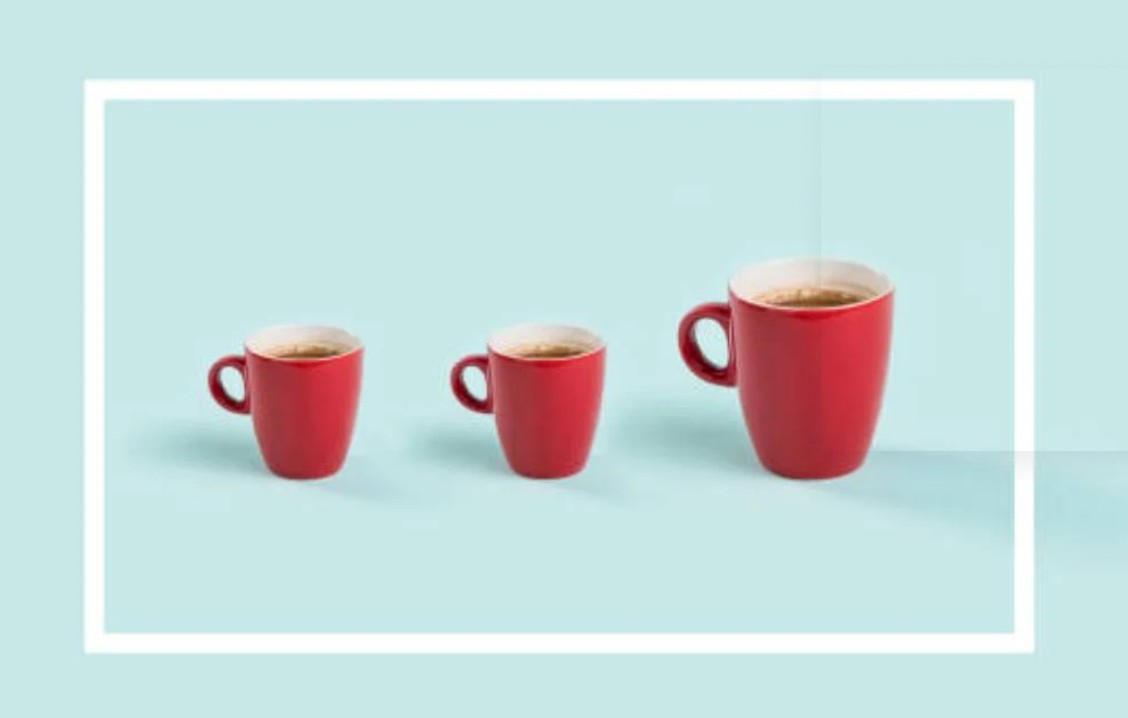
Italy:
Takeaway: In Italy, the practice of takeaway coffee is not as popular as in other countries. On the other hand, when Italians are selecting takeaway, they will go for the smaller sizes of 4-6 fl oz (118.3-177.4 ml) to ensure that the espresso is not compromised.
In-store: A typical Italian espresso cup ranges from 2-3 fl oz (59-89 ml) and is served in small, thick-walled demitasse cups. Cappuccinos and lattes are commonly served in slightly bigger cups, that is, 5-6 fl oz (147.9-177.4 ml).
Japan
Takeaway: Japanese takeaway cups run smaller than their U.S. counterparts, topping out at 8–12 fl oz (236–355 ml). The modest size reflects the local standard of roughly 6.5 fl oz (192 ml) per serving.
In-store: Sit-down orders are poured into even smaller mugs—usually 6–8 fl oz (177–237 ml). That said, cafés in Tokyo and Osaka have begun offering larger sizes to court younger drinkers and Western-style tastes.
Australia and New Zealand:
Takeaway: The takeaway coffee cups in Australia and New Zealand are similar to those in the U.S. but common sizes in the region are 8 fl oz (236.6 ml), 12 fl oz (354.9 ml), and 16 fl oz (473.2 ml).
In-store: Australian and New Zealand shop standard cup size is about 8.8 fl oz (260 ml), and this is a bit larger than the traditional Italian espresso cup. This size is a favorite for drinks like flat whites and long blacks, which are the regulars in the local coffee culture.
Turkey
Takeaway: Coffee-to-go is rare. Turkish coffee is meant to be sipped slowly in company, so most cafés focus on the in-store ritual rather than grab-and-go cups.
In-store: The drink arrives in a demitasse known as a fincan—hand-painted, porcelain, and holding just 2–3 fl oz (59–89 ml) of the thick, aromatic brew. The petite volume keeps the flavor intense and the break brief, usually paired with a glass of water and a square of Turkish delight.
Choosing the Right Cup Size for Your Coffee Shop
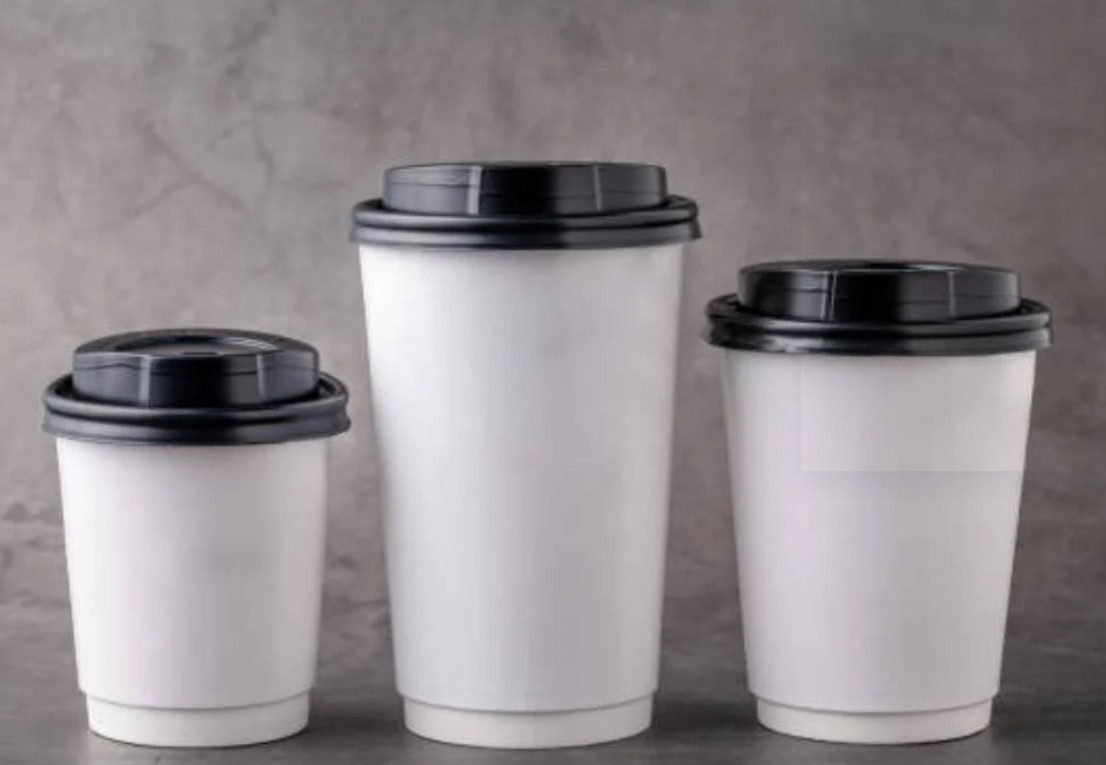
When picking the cup sizes for your coffee shop, there are a few things to think about:
First, you need to understand what your customers like. Are they the people who are always in a hurry and prefer the oversized ones? Should customers choose bigger cups or smaller, more traditional-sized ones?
Next, The shape and material of a cup quietly shape the way coffee tastes. A wide rim lets more aroma reach the nose, so the first sip feels fuller and more complex. A thick ceramic wall traps heat, keeping the drink warmer—and the flavor steadier—long enough for a second or third sip. These small choices send a clear message to your customers about the care behind every brew.
Next, consider what coffee drinks you will be providing. If you mainly make espresso drinks, like cappuccinos and lattes, then you may need different sizes. In this way, you can give people who like various amounts of milk and espresso.
In addition, consider what effect the cups sizes will have on the overall workflow and efficiency. Bigger cups could need more time to fill up and to be ready. The service of smaller cups can be sped up in your peak hours.
Finally, the size of the cup you select may also be an important part of your branding and the overall look of your coffee shop. Select sizes that are appropriate for your brand and your coffee drinks look great.
Ultimately, Finding the right balance is key. When selecting cup sizes, you want to keep customers happy, operations smooth, and your brand image strong. At Xinyujie, we provide wholesale disposable coffee cups that combine durability with customization, helping you build a consistent brand experience from the first sip.
Coffee Cup Selection Checklist
To help you make a confident decision, use this checklist to evaluate your options:
Customer Demographics & Habits:
[ ] Do my customers primarily get coffee to go (takeaway)?
[ ] Do a significant number of customers stay to enjoy their coffee in-store?
[ ] Do they prefer large, American-style servings or smaller, traditional European sizes?
Menu & Drink Types:
[ ] Do I sell many cold or iced beverages?
[ ] Do I offer a wide range of hot drinks (e.g., espresso, latte, cappuccino)?
[ ] Do my specialty drinks require extra space for milk, foam, or toppings?
Workflow & Operations:
[ ] Can my staff efficiently prepare drinks with the chosen cup sizes?
[ ] Do the cups stack easily to save storage space?
[ ] Will larger cups slow down service during peak hours?
Branding & Aesthetics:
[ ] Are the cups suitable for custom printing of my logo or brand message?
[ ] Do the cup sizes align with my brand’s image (e.g., modern, traditional, minimalist)?
[ ] Do the cups and mugs visually enhance the drinks they contain?
Cost & Sustainability:
[ ] Are the materials eco-friendly or recyclable?
[ ] Are the cups budget-friendly, considering both initial cost and long-term usage?
[ ] Can I find a reliable supplier who can provide consistent quality and timely delivery?
Smart Sourcing: Finding the Right Supplier
The cup matters, but the supplier matters just as much. A solid sourcing plan looks past the price tag and focuses on five essentials:
1. Material & Sustainability
Insist on cups that feel sturdy in the hand and hold up under heat. If your brand leans green, ask for FSC-certified paper, plant-based linings, or fully recyclable options.
2. Custom Printing
Your logo should travel with every drink. Make sure the supplier can run full-color, food-safe prints in the exact Pantone you need.
3. Size Range
One menu, many drinks. Confirm they stock everything from 2-oz espresso cups to 24-oz cold tumblers—so you’re never forced to pour a flat white into a giant latte cup.
4. Reliability & Logistics
Peak season or sudden promo, you need cups on the shelf. Ask about lead times, minimum orders, and how they handle rush shipments.
5. Support That Answers the Phone
When a design file corrupts or a pallet goes missing, you want a real person who fixes it today—not next week.
Get these five right, and the right cup becomes the easy part.
Xinyujie: We are Your Recommended Supplier for Paper Coffee Cups
At Xinyujie, we are well aware of how essential it is for you to have reliable high-end paper coffee cups for your coffee shop. Our paper cup factory is a reliable supplier among the coffee cup manufacturers, and we have a wide variety of cup sizes to meet your specific demands.
Our coffee paper cups are built with planet-friendly materials that lock in heat and let the flavor shine. Stock an 8 oz for the daily drip, or scale up to our larger sizes when the order calls for a signature latte or iced cold brew.
Along with our many cup sizes and many types of coffee cups, Xinyujie also have custom printing. This allows you to promote your brand and make your customers remember you. Our team of experts is dedicated to providing you with top-notch customer service. We will ensure that your coffee shop has a dependable source of high-end paper cups made to last with durable, quality materials at all times.
Conclusion
Cup size may look like a small detail, yet it quietly shapes how customers judge value, speed, and even flavor. Once you map standard volumes against local habits, drink recipes, and your own brand story, the right sizes become obvious.
Keep four things in view while you choose: who your regulars are, what your menu promises, how quickly your baristas can work, and how every cup advertises your name. When you’re ready to lock in supply, Xinyujie delivers the recyclable paper cups you need—printed, packed, and shipped on time—so your shop can focus on pouring the next perfect drink.
